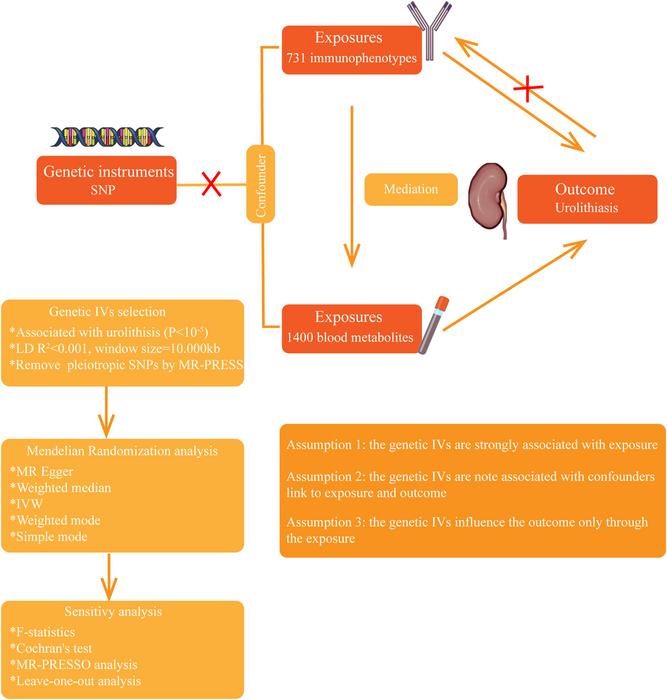
A groundbreaking study recently published in the prestigious journal Genes & Diseases unveils novel insights into the complex interplay between immune cell characteristics, blood metabolites, and the risk of developing urolithiasis, a condition marked by the formation of urinary stones. Utilizing advanced methods such as Mendelian randomization (MR) and mediation analysis, the research pioneers a pathway to understanding how genetically predicted blood metabolites serve as mediators between immune system profiles and the pathogenesis of urinary stones. This innovative approach uncovers a unidirectional causal relationship, offering new potential avenues for therapeutic intervention in a disease that affects millions worldwide.
Urolithiasis remains a significant public health issue, with prevalence rates escalating globally to affect approximately 10-15% of the population. The burden of urinary stone disease is exacerbated by its recurrent nature and multifactorial etiology, which encompasses immune dysregulation and metabolic imbalances. These interrelated pathophysiological processes have posed challenges to researchers seeking to fully elucidate the mechanisms underlying stone formation. By leveraging genome-wide association studies (GWAS) data from nearly half a million individuals, this study stands at the forefront of gene-to-disease research, examining over 6,000 urolithiasis cases alongside more than 480,000 controls.
The investigative team applied a two-sample Mendelian randomization approach, a statistical method that uses genetic variants as instrumental variables to infer causality between exposures and outcomes, minimizing confounding factors inherent in observational studies. This robust method allowed the researchers to dissect the causal impacts of immune cell features and metabolite levels on stone formation risk. The genetic instruments were meticulously selected from large-scale GWAS datasets, providing high statistical power and reliability in their causal estimates.
.adsslot_4UPiMvDedg{width:728px !important;height:90px !important;}
@media(max-width:1199px){ .adsslot_4UPiMvDedg{width:468px !important;height:60px !important;}
}
@media(max-width:767px){ .adsslot_4UPiMvDedg{width:320px !important;height:50px !important;}
}
ADVERTISEMENT
Key findings from the analysis brought to light ten immune cell characteristics with significant associations to urolithiasis risk. Notably, specific markers within the B cell subset, regulatory T (Treg) cells, and conventional dendritic cells (CDC) were implicated. For example, elevated levels of IgD-CD24-% lymphocytes and CD24 expression on transitional B cells were linked to an increased risk profile. Similarly, subsets of Treg cells, such as CD25 expression on IgD+ CD38- naïve cells and CD4 Treg percentages, were also shown to enhance susceptibility to urinary stones. Conversely, certain immune markers including HLA DR expression on plasmacytoid dendritic cells, conventional dendritic cells, and B cells conferred a protective effect against urolithiasis, indicating a nuanced immune landscape influencing disease susceptibility.
Importantly, reverse Mendelian randomization analyses provided no support for urolithiasis influencing immune cell characteristics, underscoring the predominantly unidirectional nature of the relationship. This finding strengthens the argument for immune profiling as a predisposing factor rather than a consequence of stone formation, a critical distinction for future biomarker development and clinical management strategies.
The metabolic dimension of this research identified thirteen blood metabolites associated with urolithiasis, encompassing diverse biochemical categories such as lipids, amino acids, carbohydrates, and metabolite ratios. Among these, glycolithocholate and 4-hydroxychlorothalonil (4-OH-CHT) emerged as metabolites associated with heightened stone risk, whereas stearidonate and sphingomyelin were linked to reduced risk, suggesting metabolic profiles may modulate pathological processes in stone disease. Intriguingly, glycolithocholate and 1-oleoyl-2-linoleoyl-GPE were found to positively mediate the relationship between B cell traits and urinary stone risk, whereas 4-OH-CHT appeared to negatively mediate the association between CD4 Treg cells and urolithiasis development.
These comprehensive results highlight the integral role of blood metabolites in governing immune-mediated mechanisms of urinary stone formation. By revealing metabolic pathways that intersect with immune cell dynamics, the study significantly advances our understanding of urolithiasis pathogenesis. Such insights herald the possibility of exploiting immune-metabolic interactions as novel targets for therapeutic intervention, potentially transforming current approaches to prevention and management.
The implications extend beyond mere risk stratification; identifying these immune-metabolic biomarkers offers a dual opportunity. Clinicians may harness this knowledge for enhanced, personalized prediction models, while pharmaceutical research might explore these pathways for drug discovery. Innovations aimed at modulating specific immune cells or correcting metabolic derangements could yield next-generation therapies aimed at reducing stone recurrence and associated morbidity.
Technically, the utilization of Mendelian randomization combined with mediation analysis exemplifies the power of integrative genomics in unraveling causal relationships within complex diseases. This methodological synergy allows for disentangling the direct effects of immune features as well as their indirect influences mediated via metabolites, forming a comprehensive picture of disease etiology that surpasses conventional observational insights.
Moreover, the large-scale nature of the data reinforces the robustness of the findings, encompassing diverse genetic backgrounds and clinical phenotypes. The extensive sample size diminishes the likelihood of spurious associations, providing confidence in the identified causal factors and their biological relevance.
Going forward, future research may expand upon these foundations by exploring environmentally induced exposures in combination with genetically predicted profiles, offering a more holistic view of urolithiasis risk. Furthermore, validating these biomarkers in clinical cohorts will be crucial to translating these findings into tangible diagnostic tools or targeted therapies.
In conclusion, this landmark study elegantly delineates the mechanistic links between immune cell characteristics, blood metabolites, and urolithiasis development through sophisticated genetic epidemiological analyses. By pinpointing novel immune and metabolic targets, it paves the way for innovative preventive measures and personalized therapeutic strategies, addressing a critical need in a disease affecting a substantial fraction of the global population.
Subject of Research: Genetic and metabolic factors mediating immune cell influence on urolithiasis risk.
Article Title: Genetically predicted blood metabolites mediate the association between immune cell characteristics and urolithiasis: A Mendelian randomization study and mediation analysis.
News Publication Date: 2025
References:
Chengcheng Wei, Jiattai He, Jun Wen, Shunyao Wang, Mengjia Shi, Juan Hu, Huanhuan Tan, Jinjun Guo, Xiaosong Li, Genes & Diseases, 2025, 101547, DOI: 10.1016/j.gendis.2025.101547
Image Credits: Genes & Diseases
Keywords: Urolithiasis, Immune Cell Characteristics, Blood Metabolites, Mendelian Randomization, Mediation Analysis, B Cells, Regulatory T Cells, Metabolic Pathways, GWAS, Urinary Stones
Tags: blood metabolites and immune cellsgene-to-disease research in urolithiasisgenome-wide association studies in urolithiasisimmune dysregulation in urolithiasisMendelian randomization studymetabolic imbalances and kidney stonespathogenesis of urinary stonesprevalence of urinary stonespublic health issues related to kidney stonestherapeutic interventions for urolithiasisurinary stone diseaseurolithiasis risk factors





